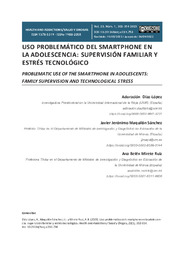Please use this identifier to cite or link to this item:
https://hdl.handle.net/11000/29168Full metadata record
| DC Field | Value | Language |
|---|---|---|
| dc.contributor.author | Díaz López, Adoración | - |
| dc.contributor.author | Maquilón, Javier | - |
| dc.contributor.author | Mirete Ruiz, Ana Belén | - |
| dc.contributor.other | Departamentos de la UMH::Psicología de la Salud | es_ES |
| dc.date.accessioned | 2023-04-19T11:14:29Z | - |
| dc.date.available | 2023-04-19T11:14:29Z | - |
| dc.date.created | 2023-01 | - |
| dc.identifier.citation | Health and Addictions/Salud y Drogas Vol. 23 Núm. 1 (2023) | es_ES |
| dc.identifier.issn | 1988-205X | - |
| dc.identifier.issn | 1578-5319 | - |
| dc.identifier.uri | https://hdl.handle.net/11000/29168 | - |
| dc.description.abstract | El uso problemático del Smartphone en la adolescencia es una de las principales problemáticas educativas y sociales de la actualidad. Con la finalidad de profundizar en este análisis se formularon los siguientes objetivos: 1) Describir comportamientos indicadores de uso problemático del Smartphone; 2) Analizar la relación entre la frecuencia de uso del Smartphone y los indicadores de uso problemático; 3) Analizar la relación entre la supervisión familiar y los indicadores de uso problemático del Smartphone; 4) Analizar los factores predictores del estrés tecnológico. La muestra estuvo compuesta por 1.101 participantes. Se optó por un diseño cuantitativo no experimental tipo en- cuesta. Se realizó un análisis descriptivo y se emplearon tablas de contingencia, Chi Cuadrado, V de Cramer y análisis de Regresión Lineal. Los resultados arrojaron que más del 30% de los encuestado se quedan despiertos hasta tarde usando el móvil, 1 de cada 10 se siente estresado si no recibe mensajes o llamadas y otro 30% considera más sencillo relacionarse a través de Internet. Se concluye subrayando que la alta frecuencia de uso del Smartphone provoca desajustes en el descanso, la irritabilidad y los niveles de estrés de los jóvenes, mientras que la supervisión familiar disminuye la intensidad de estos indicadores | es_ES |
| dc.description.abstract | The problematic use of the Smartphone in adolescence is one of the main educational and social problems of to- day. In order to deepen this analysis, the following objectives were formulated: 1) Describe behaviors that indicate problematic use of the Smartphone; 2) Analyze the relationship between the frequency of use of the Smartphone and the indicators of problematic use; 3) Analyze the relationship between family supervision and indicators of problematic use of the Smartphone; 4) Analyze the predictors of technological stress. The sample consisted of 1,101 participants. A non-experimental survey-type quantitative design was chosen. A descriptive analysis was carried out and contingency tables, Chi Square, Cramer’s V and Linear Regression analysis were used. The results showed that more than 30% of those surveyed stay up late using their mobile phones, 1 in 10 feel stressed if they do not receive messages or calls, and another 30% consider it easier to relate via the Internet. It concludes by emphasizing that the high frequency of use of the Smartphone causes imbalances in rest, irritability and stress levels in young people, while family supervision reduces the risks of suffering them | es_ES |
| dc.format | application/pdf | es_ES |
| dc.format.extent | 13 | es_ES |
| dc.language.iso | spa | es_ES |
| dc.publisher | Universidad Miguel Hernández de Elche | es_ES |
| dc.rights | info:eu-repo/semantics/openAccess | es_ES |
| dc.rights.uri | http://creativecommons.org/licenses/by-nc-nd/4.0/ | * |
| dc.subject | Teléfono móvil | es_ES |
| dc.subject | supervisión familiar | es_ES |
| dc.subject | uso problemático | es_ES |
| dc.subject | adolescencia | es_ES |
| dc.subject | Internet | es_ES |
| dc.subject | Smartphone | es_ES |
| dc.subject | familiar supervision | es_ES |
| dc.subject | problematic use | es_ES |
| dc.subject | adolescence | es_ES |
| dc.subject.other | CDU::1 - Filosofía y psicología::159.9 - Psicología | es_ES |
| dc.title | Uso problemático del smartphone en la adolescencia: supervisión familiar y estrés tecnológico | es_ES |
| dc.title.alternative | Problematic use of the smartphone in adolescents: family supervision and technological stress | es_ES |
| dc.type | info:eu-repo/semantics/article | es_ES |
| dc.relation.publisherversion | https://doi.org/10.21134/haaj.v23i1.758 | es_ES |

View/Open:
758-Texto del artículo-4777-1-10-20230128.pdf
484,48 kB
Adobe PDF
Share:
.png)
